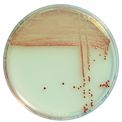bioMérieux launches CampyFood ID, the first culture medium for easy detection of Campylobacter
 01 Giugno, 2006
01 Giugno, 2006
bioMérieux announces a new innovation in food microbiology with CampyFood ID, the first ready-to-use culture medium for easy detection of Campylobacter in food products and environmental samples.
The innovation behind CampyFood ID
Conventional charcoal or blood media are not easily readable and make the Campylobacter analysis complex and long. CampyFood ID is different in that it is composed of a specific combination of a coloured indicator with antibiotics. The colonies that form on the clear agar turn orange-red, making it extremely easy to distinguish them.
Campylobacter and regulations
Although testing for Campylobacter is seldom required by regulations, agri-food companies have a responsibility for adopting the safety measures to be implemented in order to guarantee food safety. The European Food Safety Authority (EFSA) recommends using a monitoring plan to reduce the risk related to Campylobacter infection and a new ISO standard for the detection of Campylobacter spp was recently issued (ISO 10272-1:2006).
Thanks to CampyFood ID, all microbiology laboratories can now control this public health issue and the levels of contamination in food and environmental samples in food production and animal breeding facilities can finally be assessed.
bioMérieux’s expertise
bioMérieux, the first European manufacturer of ready-to-use culture media, is confirming its food microbiology innovations strategy for the detection of pathogenic bacteria.
Backed by extensive experience in developing and manufacturing of a host of culture media, bioMérieux offers a vast range of complex, chromogenic media that make microbiological testing easier and more reliable:
- Ottaviani Agosti Agar (Detection and enumeration of Listeria and L. monocytogenes)
- SM ID 2 (Salmonella detection)
- COLI ID (Detection of E. coli and total coliforms)
- O157:H7 ID (Detection of E. coli O157:H7)
- CampyFood ID (Campylobacter detection)
About Campylobacter
Campylobacter is a major public health issue with a considerable socio-economic impact. Foods are a significant risk factor for human campylobacteriosis, and the infectious dose seems to be very low. Poultry-based foods are assumed to be the primary source of campylobacteriosis, with the main routes of infection being the ingestion of inadequately cooked meat (primarily poultry) and cross-contamination. Campylobacter, primarily C. jejuni, is the third leading cause of death from foodborne infections in the world. This pathogen is the cause of enteric infections that can be severe enough to cause death or serious neurological damage.

